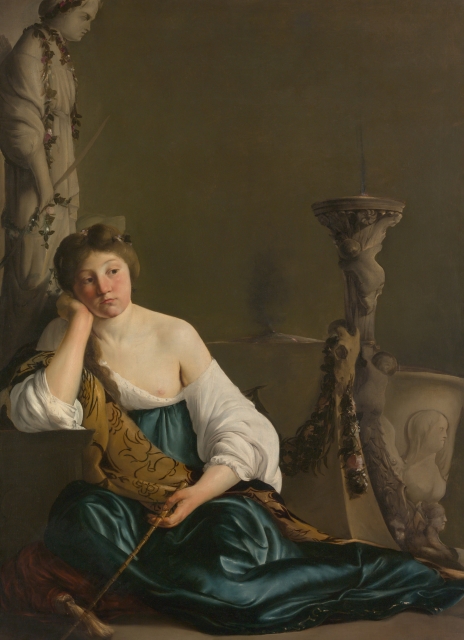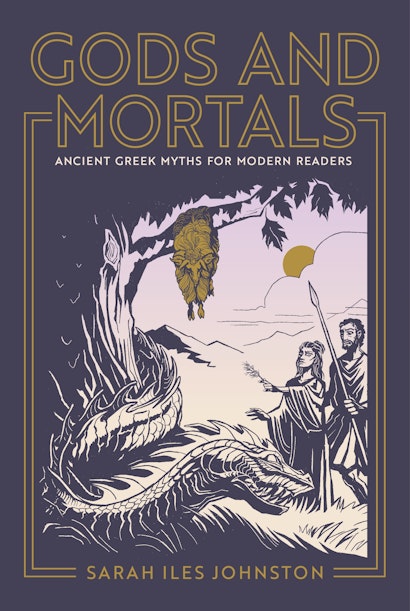When I received my first copy of the book I recently published with Princeton (Gods and Mortals: Ancient Greek Myths for Modern Readers), I suddenly realized that its dust-jacket was the second on which my name shares space with a picture of Medea. The first, which was also published by Princeton, is a 1997 volume that I co-edited with James J. Clauss: Medea: Essays on Medea in Myth, Literature, Philosophy and Art.
That Medea should appear on the 1997 jacket was a foregone conclusion, given the book’s topic. For that, Jim Clauss and I chose Frederick Sandys’ 1868 painting of a soul-tortured Medea, who claws at a necklace of coral beads around her neck and stares out at us in despair. Although she is surrounded by the accoutrements of a magical spell that she is performing, which gestures to her mastery of an arcane science, the predominant impression is of a woman who is being victimized by a love-charm that the gods have cast upon her, compelling her to use her special knowledge to help the hero Jason.
Twenty-five years later, when I started envisioning the new jacket illustration, I decided it should include two things. The first was a monster, because nothing says ‘Greek myth’ like a great monster. The second was a woman with agency—not a victim waiting to be rescued from a monster, such as Andromeda chained to a rock, helpless fodder for a sea serpent, but someone who was herself involved in fighting the monster. One candidate was Ariadne, without whose help Theseus couldn’t have conquered the Minotaur. But Ariadne and the Minotaur never appear in the story at the same moment, which made it impossible to put both in the same jacket illustration. Another candidate was Circe, whose special knowledge enabled Odysseus and his men to survive encounters with the Sirens, Scylla and Charybdis. But like Ariadne, Circe doesn’t appear in the story at the same time as the monsters do.
And then I remembered Medea, who not only gives Jason the knowledge and the magical salve that will allow him to survive the challenges that her father sets, but who also leads Jason to the tree where the Golden Fleece hangs. Then, according to the best-known version of the story, by the Greek author Apollonius of Rhodes, Medea herself conquers the dragon that coils around that tree, guarding the Fleece. To do so, she chants a spell that conjures sleep and uses a juniper sprig to shake a potion that she has created onto the dragon’s eyes. Jason leaps forward to snatch the Fleece from the tree only after the dragon has crumpled to the ground, insensible.
I had my subject matter, and my illustrator carried it out wonderfully: the dragon coils mightily, all the way around to the back of the book jacket, but Medea (who looks very much like Maria Callas in her famous performance of the role) fixes it with her gimlet eye and commandingly extends the hand that holds the juniper sprig.
In the years between the two books, I had learned more about Medea and about the craft that she practiced. Nowadays, she is frequently referred to as a witch, a term that often implies either an inborn ability to practice magic or an ability that is bestowed by some supernatural power with whom the aspiring witch has made a deal.
There is no ancient Greek equivalent of the word ‘witch,’ however, in that sense of the word. The Greeks talked about magicians, who were understood to have acquired their craft through long study and apprenticeship to experts. The process was, broadly speaking, similar to that employed at Hogwarts (which shouldn’t surprise us, perhaps, given that J.K. Rowling was a Classics major).
All of the real practitioners of magic whom we know about from historical Greece were men, but in myths, a few women are represented as practicing magic as well, Medea and her aunt Circe being the best-known examples. In her novel Circe, Madeline Miller portrays Circe as dedicating a great deal of time and effort to learning the properties of natural substances and how to use them—a portrait that is already hinted at in ancient texts. In the Odyssey, for instance, Circe is described as using pharmaka, a noun that embraces plants and all manner of other natural substances that can be used in spells, as long as the practitioner knows what they’re doing. The Roman poet Ovid describes Circe as ‘knowing well the potency of every leaf, what ingredients to mix together and how much of each.’ The Greek historian Diodorus Siculus credits Circe with discovering the natures and powers of many hitherto unknown plants—although he also notes that she learned a great deal from Hecate, whom Diodorus idiosyncratically makes Circe’s mother. Diodorus makes Medea the daughter of Hecate, as well, and thus the sister of Circe, and he claims that Medea learned ‘all the powers that pharmaka possess’ from her mother and sister. In Gods and Mortals, I developed this and other ancient references to Medea’s studious acquisition of her knowledge into a picture of Medea as a dedicated scholar of magic.
Nowadays, the first thing we tend to think of when we hear the name Medea is the fact that she eventually murdered her two children after Jason dumped her to make a more politically advantageous marriage. That side of Medea cannot be ignored, but it’s worth noting that her reputation as a smart, resourceful and innovative woman was long remembered, as well. The third-century CE polymath Philostratus of Athens tells a fascinating story about an engineering project that Medea undertook after she left Jason behind and became the queen of Babylon. Wishing to devise a means of crossing the Euphrates without the risk of getting wet, she temporarily diverted the river into lakes and then had a channel dug out, two fathoms deep, across the temporarily dry riverbed. Her workers lined the channel with boulders and soft pitch and built a roof for it from the same materials, level with the bottom of the riverbed. As soon as the water was allowed to run back into its normal course, it caused the pitch to harden, stabilizing Medea’s new underwater passage.
Eleven hundred years later, when Boccaccio contemplated Medea in his On Famous Women, he described her as cruel, treacherous and foolish, but his opening statement also calls her ‘a most-learned woman.’ When he listed what she was able to accomplish by ‘singing enchantments’ (a phrase that encompassed a range of magical acts, including but not limited to singing) he gave some that have a scientific ring. She ‘dammed up rivers,’ for example, and ‘compounded elaborate fires that could cause any kind of conflagration.’ The first, perhaps, gestures towards Philostratus’ story of the tunnel beneath the Euphrates. The second probably refers to the way that, as Euripides and others had vividly narrated, Medea killed a rival in love by sending her a poisoned cloak; when the poor woman put it on, she burst into flames. Boccaccio seems to have seen in that act the rudiments of what we would now call chemical knowledge.
We have all but lost sight of this learnéd Medea, nowadays. Maria Callas, Diana Rigg, Fiona Shaw and others have given us brilliant portrayals of the cheated wife and tortured infanticide, but the woman who labored to acquire a knowledge of where the hidden powers of the cosmos were lodged and how to put them to use has seldom been celebrated, or even contemplated. We need to return to Medea, again.
Sarah Iles Johnston is the College of Arts and Sciences Distinguished Professor of Religion and Professor of Classics at The Ohio State University, where she teaches courses on Greek myths. Her many books include The Story of Myth, Ancient Greek Divination, and Restless Dead: Encounters between the Living and the Dead in Ancient Greece.


